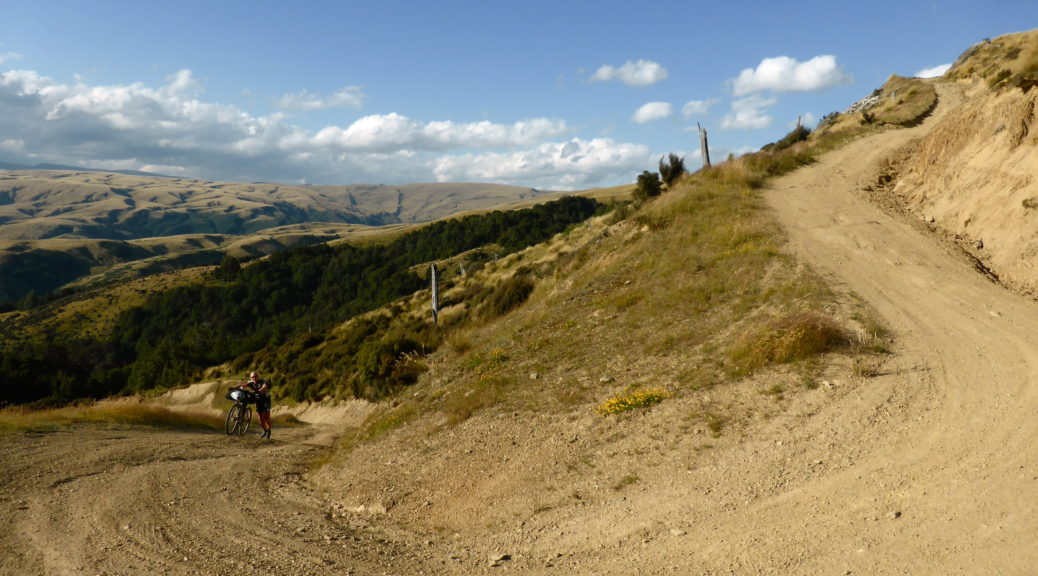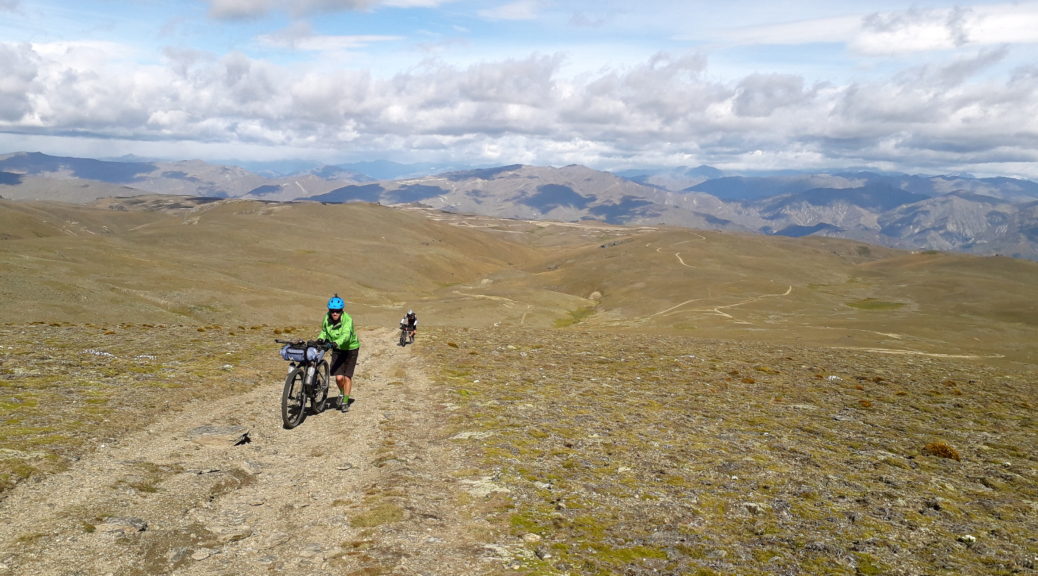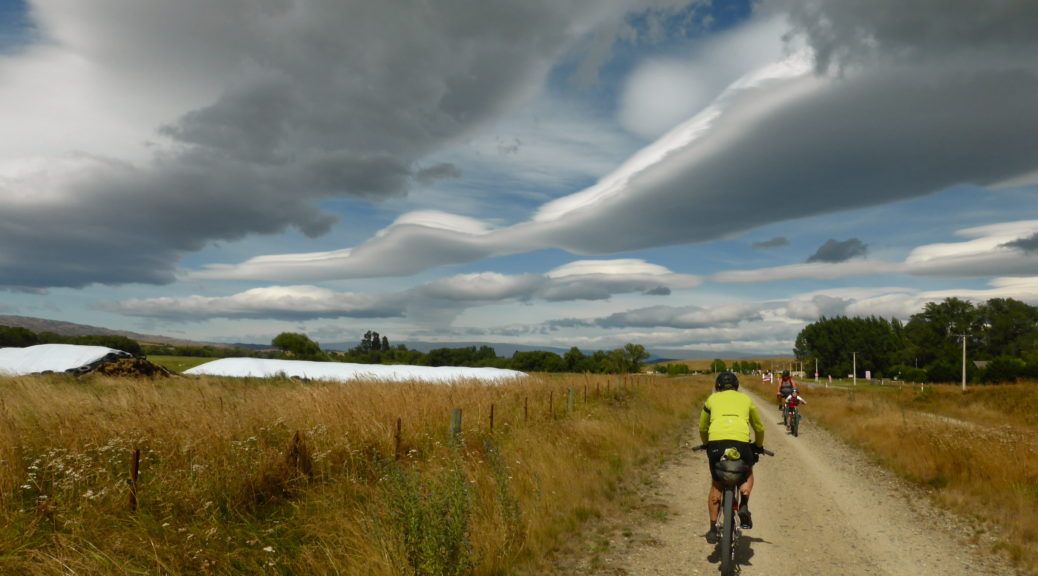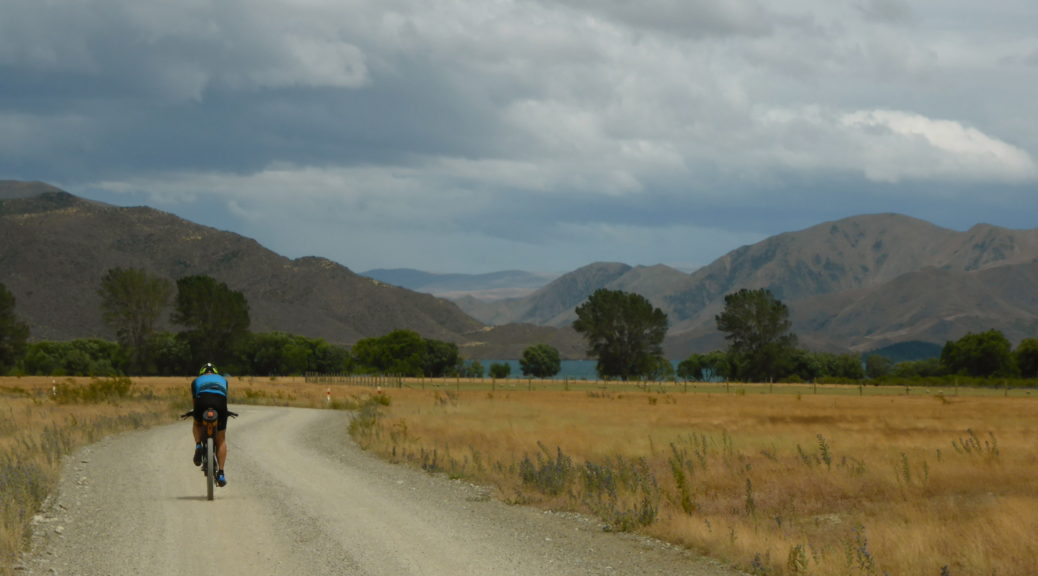In the lee of the caravan, I slept soundly and didn’t have too many problems rolling out at five o’clock into much calmer conditions. At Nevis Crossing I was surprised to spot four tents and bikes roadside. Who were these people, when did they pass me? They must have rode late into the night. I didn’t see them again.
I’d conveniently forgotten that getting out of the valley was a gradual forty kilometre climb. This didn’t really matter as things were so much better out of the wind and lightening of the surrounds brought new sights that I enjoyed. As always on these events, it’d be great to return and take a bit more time to poke around the landscape and history.
 The valley narrowed and the grade increased slightly.
The valley narrowed and the grade increased slightly.
Opening of the valley a little increased the views, creek crossings gave the opportunity to wet one’s feet. Taking in the hills surrounding me on all sides I began to speculate where the route out may lead. It was a fairly straight road out, only kicking up a little to take me over into Southland at 1100 m. Looking at the map now, I’m bitterly disappointed I didn’t notice, much less take, the excellently named Roaring Lion Trail to the side.
 Pointing the front wheel down, soon I was past the historic Garston Ski Hut – making a note to return here with a beefier mountain bike and explore further.
Pointing the front wheel down, soon I was past the historic Garston Ski Hut – making a note to return here with a beefier mountain bike and explore further.
 There was over seven hundred metres to lose plunging down the exhilarating gravel to the Mataura valley floor. Reacquainting myself with the fierce norwester, I was slowed a little.
There was over seven hundred metres to lose plunging down the exhilarating gravel to the Mataura valley floor. Reacquainting myself with the fierce norwester, I was slowed a little.
 Snaking down the hills took me to a short stretch of highway and onto Garston (apparently the most-inland settlement in New Zealand; who knew?).
Snaking down the hills took me to a short stretch of highway and onto Garston (apparently the most-inland settlement in New Zealand; who knew?).
Nine o’clock on a Tuesday morning didn’t give many options for second breakfast, but a food van was more than enough. Cheese roll to accompany breakfast? Why not, I was in Southland for a day… Joining the Around the Mountains trail to Lumsden, the route was on or near the old rail corridor passing through small towns and many pastoral scenes.


With the course slowly going around base of the foothills of the Garvie Mountains, it was flat riding that was only hampered by the gale. But as I curved around towards Lumsden, the wind became more helpful until finally I was blown into town. Taking the opportunity to resupply for the upcoming remoteness of the Old Man Range, I was surprised to return to my bike and find that my gloves, buff and sunnies were blowing down the street – my helmet having been whipped off my handlebars by the gusts. I didn’t find my sunnies, but figured I could go without. I also found that I’d briefly caught up to Steve and Jake, they’d had far less sleep on the balcony of a very old house further up the Nevis than my awning.
Flat road out of town had the wind directly behind me, it sure was fun flying down long straight gravel roads – except when exceedingly large tractors appeared from clouds of dust. Turning north east, the road was not straight; any part of the route with a more northerly aspect brought me to a standstill. I realised that being without eye protection was not good with the amount of pollen and dust being whipped around. My eyes begin to puff up and close. For the third day in a row, I was blown off my bike by the wind – a good opportunity to take some hayfever meds and hope my eyes might settle and open a little.
Crossing the Waikaia River, I rolled into the eponymous settlement and up to Jake and Steve outside the store – time for ice cream for respite from the heat. None of us were too sure what we would find on the upcoming range and as it was mid-afternoon, I was happy to have company as we headed up the valley to Piano Flat battling the wind.
 More trail angels! I hardly knew where I was in the country, but there was an invitation to come to the farmhouse for tea. I don’t know how I passed that up, the goodies in the box probably helped.
More trail angels! I hardly knew where I was in the country, but there was an invitation to come to the farmhouse for tea. I don’t know how I passed that up, the goodies in the box probably helped.
 After lovely riverside riding for some time, we entered dense native forest and the steep undulating climbs and descents began.
After lovely riverside riding for some time, we entered dense native forest and the steep undulating climbs and descents began.
Turning off the deteriorating road, the 4WD track seemed to plump for the direct route to the top of the Old Man. We paused to eat at the derelict Christies Hut before starting the push up through 700 m over five kilometres. Slow progress, it was at least steady and manageable – I was glad to have the wind behind us.
 As the afternoon drew to a close there was now not excessive heat in the wind.
As the afternoon drew to a close there was now not excessive heat in the wind.
 It flattened out, a bit, and was rideable in parts.
It flattened out, a bit, and was rideable in parts.
Turning north, we straddled the provincial boundary. While a kinder gradient, the insane crosswind hampered progress as the shadows lengthened. Nearing dusk on the top of this range and making slow advances, it was obvious we would be up in this howling gale through the night. Being blown off my bike was no longer exceptional as progress consisted of a mix of slow riding, walking with some sort of order and staggering trying to stay upright.
By this stage it was a sixteen hour day for all of us, and the third consecutive day of struggling against the gale force winds. A quick trailside conflab weighed up our options, the risks of navigating along the range in the wind and darkness, our energy levels and concluded that we should only push on a little more before dropping off the ridge to a hut that Jake knew of.
Three kilometres of downhill was tough in the gloom – it was into the wind and we’d have to regain the height lost in the morning. But as darkness gathered we arrived at Potters Huts, dragged our bikes inside, fetched water, warmed with hot drinks and ate our meagre rations.
 It was hard to believe this was once a gold mining settlement of 150 hardy people. It was fierce enough up here on a clear summer’s night; winter must have been something else.
It was hard to believe this was once a gold mining settlement of 150 hardy people. It was fierce enough up here on a clear summer’s night; winter must have been something else.
 A slightly newer hut sheltered us for the night.
A slightly newer hut sheltered us for the night.
 Happy to not be trying to sleep in my bivy bag, the smell of the mattresses was best ignored.
Happy to not be trying to sleep in my bivy bag, the smell of the mattresses was best ignored.
There ended another satisfying and exhilarating day; we collapsed into bed and listened to the wind pound the corrugated iron all night. It’s probably just as well that I’ve only recently realised I was but thirty kilometres from where my day started – having ridden close on two hundred and climbed a little too! There was of course the small matter of the Old Woman Range in the way…


 Quickly I was overlooking the valley below as the sun hit the hills opposite.
Quickly I was overlooking the valley below as the sun hit the hills opposite. I was pleased to be doing this climb in the cool and shade of the early morning.
I was pleased to be doing this climb in the cool and shade of the early morning. The hut appeared soon enough and seemed a good spot for a snack and brief pause.
The hut appeared soon enough and seemed a good spot for a snack and brief pause. Kirtle Burn Hut was out of the slight valley the creek was in. I didn’t stop long, as the wind had really picked up.
Kirtle Burn Hut was out of the slight valley the creek was in. I didn’t stop long, as the wind had really picked up. A zig left and then a zag right and we were definitely on the shoulder riding up through barren rocks.
A zig left and then a zag right and we were definitely on the shoulder riding up through barren rocks. Before long, it was too steep and windy to ride.
Before long, it was too steep and windy to ride. The last time I bothered to take a photo – it was a long push up that slope from Sally’s Pinch into the wind.
The last time I bothered to take a photo – it was a long push up that slope from Sally’s Pinch into the wind. Back to Wanaka – six hours of effort didn’t seem to have got me as far as usual!
Back to Wanaka – six hours of effort didn’t seem to have got me as far as usual! Eventually I could ride again. There was much rejoicing.
Eventually I could ride again. There was much rejoicing. These flowers looked an invasive species, but they sure were pretty.
These flowers looked an invasive species, but they sure were pretty. Even at my pace, I ended up chasing much of this herd up the road as one by one they peeled off.
Even at my pace, I ended up chasing much of this herd up the road as one by one they peeled off. Eventually, I was no longer herding cattle up the road.
Eventually, I was no longer herding cattle up the road. Back towards Cromwell and Lake Dunstan.
Back towards Cromwell and Lake Dunstan. It was quite a fun drop down into the valley – I’m sure nothing to do with my legs not having to do anything.
It was quite a fun drop down into the valley – I’m sure nothing to do with my legs not having to do anything. Home for the night, wonderfully sheltered from the wind by the caravan.
Home for the night, wonderfully sheltered from the wind by the caravan.
 The sun started to hit the basin from which I’d steeply left – the track across the bottom of the frame.
The sun started to hit the basin from which I’d steeply left – the track across the bottom of the frame. Finally, the high point came into view and I crossed from Canterbury to Otago.
Finally, the high point came into view and I crossed from Canterbury to Otago. Things flattened out and opened up a bit and we joined the eastern branch of the Manuherikia River.
Things flattened out and opened up a bit and we joined the eastern branch of the Manuherikia River.  The bridge over the river had long since been washed out, but picking the right spot it was easy enough to ride through.
The bridge over the river had long since been washed out, but picking the right spot it was easy enough to ride through. Looking over the overflow intake to the Hawkdun Range, our route enters the frame from the left.
Looking over the overflow intake to the Hawkdun Range, our route enters the frame from the left. Admiring the clouds as we headed into Lauder.
Admiring the clouds as we headed into Lauder.
 First trail angel! Delicious cookies left out for GSB riders just before Albertown.
First trail angel! Delicious cookies left out for GSB riders just before Albertown.
 At the start earlier.
At the start earlier.
 Looking back north.
Looking back north. Heading south to the northern reaches of Lake Benmore.
Heading south to the northern reaches of Lake Benmore. Having followed the Tekapo River most of the day, finally we crossed it as it emptied into the Pukaki – which soon ended in the lake.
Having followed the Tekapo River most of the day, finally we crossed it as it emptied into the Pukaki – which soon ended in the lake. Joining gravel roads for a bit, we skirted around the head of the lake.
Joining gravel roads for a bit, we skirted around the head of the lake. I caught up to some others – more people to chat to; first days are fun like that.
I caught up to some others – more people to chat to; first days are fun like that.

 The pylons rise from NZ’s largest hydro station, starting the
The pylons rise from NZ’s largest hydro station, starting the